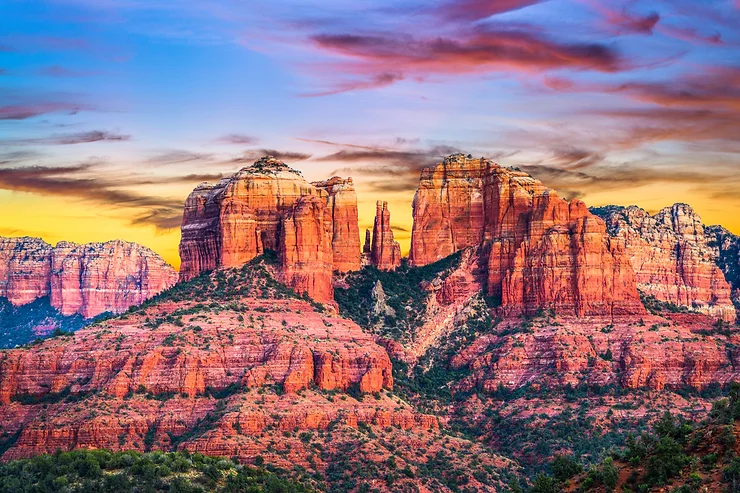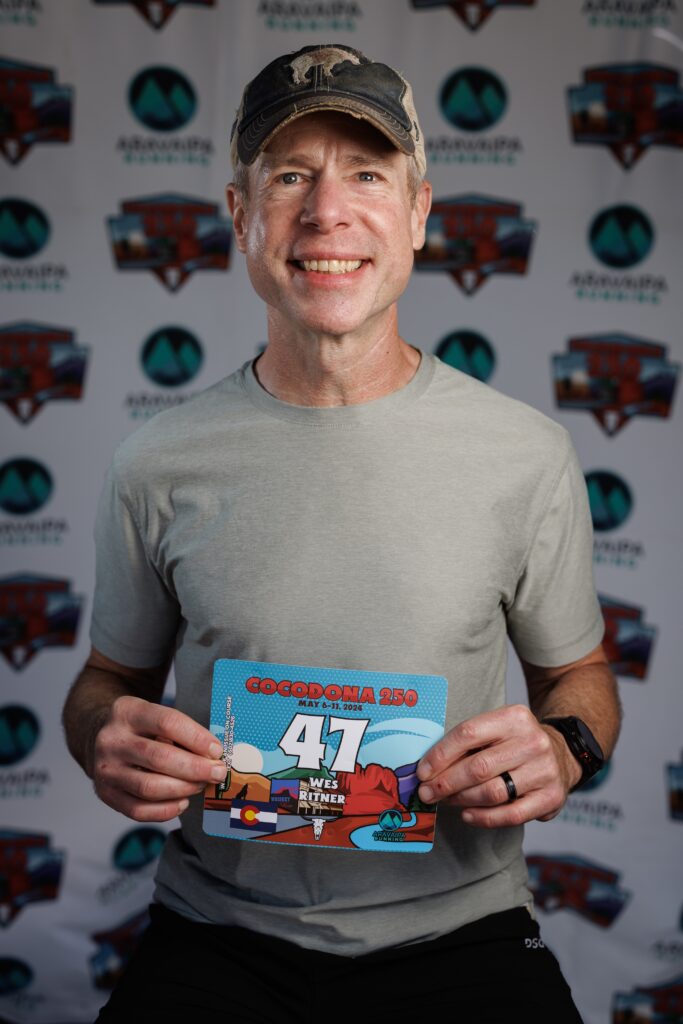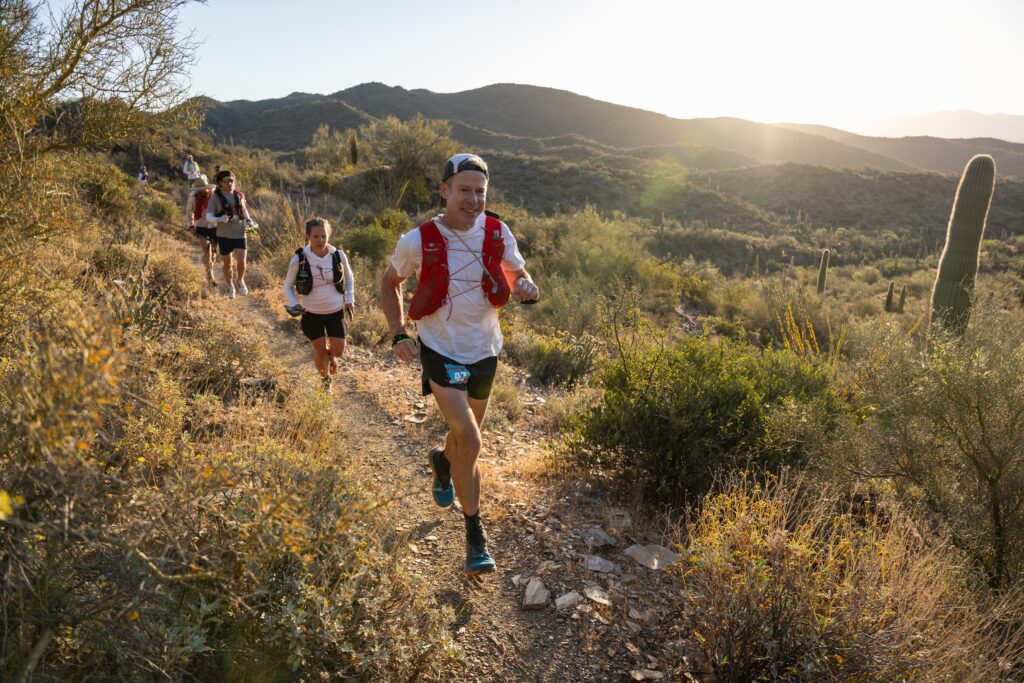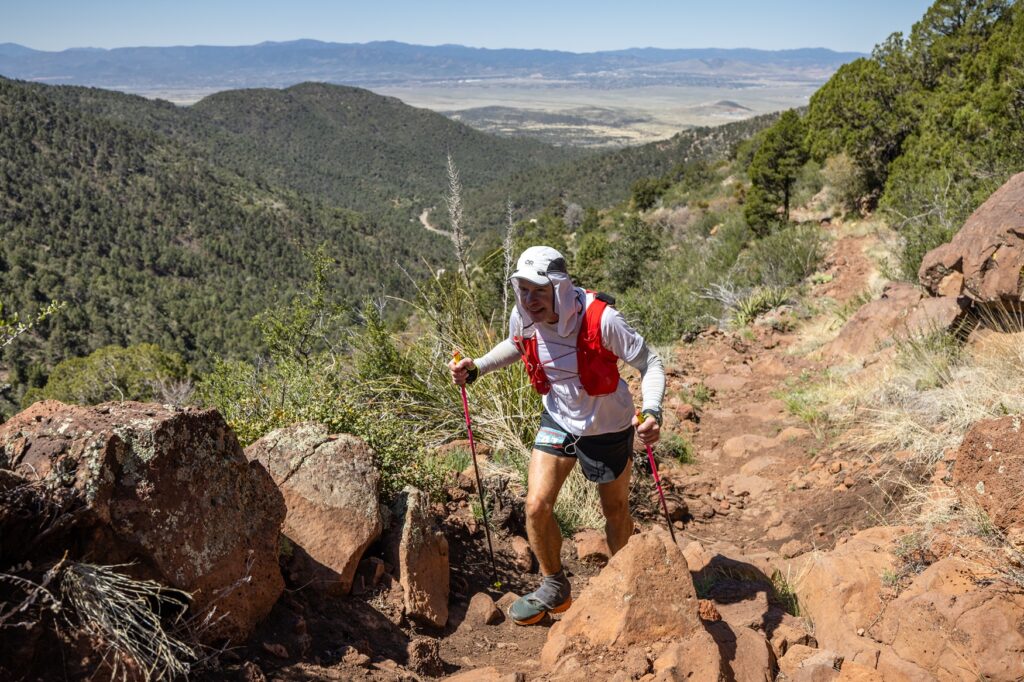
Introduction
I watched the first three years of the Cocodona 250 from afar, observing the live GPS tracker and the live video feed from the comfort of my home. It was a race that had grown in popularity quickly, and, by its fourth iteration in 2024, it had 280 participants and a long waitlist of runners who wanted to be participants. 2024 would be my first year running it. The race was scheduled to begin on May 6 in Canyon City, Arizona and would end 250 miles later in Flagstaff, Arizona. The course consisted of a lot of trails and dirt roads, along with multiple stretches of paved road. I had previewed 90 miles of the course in March of 2024, but the remaining 160 miles were going to be new to me. My wife, Heather, would crew me throughout the race. She is a fellow long-distance runner and has a strong base of experience crewing 200-mile races. Cocodona was to be her ninth 200-miler as crew, and her sixth time crewing solo.

Deep Canyon Ranch to Lane Mtn to Crown King (Mile 0 to 37)
The race started a few minutes after 5 AM on Monday morning. A surge of runners took off like they were being chased. While that wouldn’t surprise me at a 5k or even a 50k, this race was neither of those. The pace on the uphill stretches of trail was more intense than I anticipated, and the pace on the flats and buffed-out downhills seemed more appropriate for a 50-miler. This wasn’t sustainable for any of us in a 250-mile race. I had never seen so many people go so fast at the start of a 200-miler. I settled in around 50th place for those first few miles, and I still felt that if I didn’t keep running at a decent clip, I’d be trampled by the next twenty or thirty people behind me. I should have just shifted to the side of the trail and slowed down, but, probably like a lot of other people, I decided to just ride it out.
As the pack began to spread out just a little, I slowed my pace to something more sustainable. I arrived at the first aid station, mile 8, in 41st place, having passed a few people once the trail started climbing steadily. At the aid station, the line for electrolytes was long, but the water line was non-existent. The two volunteers who were supposed to be pouring water for runners were standing alone at a second set of tables with full jugs and no customers. They were actually calling out for anyone to come over to get water, and no one was responding. Fortunately, I didn’t need any electrolytes since I was carrying enough to get to the next aid station, so I skipped over to the water table, refilled some bottles, and in two minutes I was on my way.
The miles ticked by throughout the morning, and I breezed through the Lane Mountain aid station, mile 32, in less than a minute, taking only enough time to get a little water added to one of my bottles. From there it was a short climb, and then I enjoyed a nice run down to Crown King, mile 37, the first aid station at which I would see Heather. I arrived in 10th place at about 1:15 PM versus a plan of 2:30 PM. I had a fleeting thought I didn’t need to be that far ahead of my plan and maybe I should back off the pace just a little more.

Crown King to Whiskey Row (mile 37 to 78)
I continued to make good time through the early part of the evening and into the night. I was feeling strong, and my short aid station times reflected that. I departed Kamp Kipa in the dark and missed a turnoff from the main road almost immediately. I ran more than a mile past the turn, going downhill much of the way before I realized my mistake. As I hiked my way back up the ascent to the missed turn, my only consolation was that I hadn’t gone even farther of course.
Camp Wamatochik, mile 69, was another efficient stop despite fumbling with the contents of my drop bag briefly before finding what I needed. I was averaging seven minutes per aid station up to this point. So far in the race, I had managed to take in my targeted quantity of calories while keeping the electrolytes and fluids in balance with one another. My mind was focused, and my body was moving well. At one point my stomach felt a little uneasy, so, to keep my stomach from turning, I started eating only partial gels. I’d squeeze a third of a gel into my mouth as I ran, swallow it, repeat the process one more time, then squeeze the remainder of the gel into the trees. This helped physically since I wasn’t dumping as many carbohydrates into my system in a single shot. And it helped psychologically because the gels were becoming a bit of a chore for my palate, so allowing myself to consume slightly less felt almost like a reward. My caloric plan for the race included more carbohydrates than I truly needed, so I was still hitting my targeted hourly calories.

Whiskey Row to Jerome (Mile 78 to 126)
Whiskey Row aid station was housed in an open plaza between 2 buildings in the heart of the town of Prescott. Heather had set up a spot for us on one of the benches in the plaza. I came into the aid station at 12:30 AM, two hours ahead of schedule. I’d known for the last several miles that a blister had formed on the outside edge of the big toe on my right foot. Ben Light was crewing for another runner who hadn’t arrived yet, and Ben heard me mention the blister to Heather. He slipped over near our bench to help. It had been almost nine years of racing 200-milers since I’d had a blister that required attention, so I appreciated Ben’s experience in dealing with the issue. After a few bites of food, I switched to a different pair of shoes to prevent a recurrence of the blister problem, and then got moving.
It wasn’t long after I departed Whiskey Row when I started feeling sleepy. My energy was flagging. The 5 AM start was earlier than I’d experienced previously in any 200-miler, and my 3:30 AM wakeup for the race was having a more significant impact on me than I had anticipated. I’ve never successfully slept on the first night of a 200-miler, although I had tried once back in 2015 and again in 2023. Because of that, I never seriously considered sleeping on the first night when I was building my Cocodona plan. In retrospect, I probably should have reevaluated on the fly whether it was worth attempting to sleep, but at the time I went with what I knew.
Adding to the difficulty of that first night was a bout of diarrhea and excessive peeing despite the extra salt I was taking to try to retain fluids. In my mentally and physically deteriorating state, the twisting route through the Granite Dells outside of Prescott was challenging. Focusing on the white markings on the rocks was manageable, but I seemed to be winding endlessly rather than progressing forward. With no other option, I put my head down and slogged through the maze until I finally came out the other side.
After Iron King aid station, mile 91, there was a bit of road before the course became a cross-country route without a real trail. The rolling, grassy meadows were not inherently difficult, but it was frustrating to be constantly watching for ankle rollers hidden by the calf high prairie grass while simultaneously searching for the next orange marker 2 or 300 feet away tied to those same grasses. My sleepiness was not helping my attitude.
My spirits lifted a bit when the meadows were behind me and the ascent up Mingus Mountain had begun. I arrived at Mingus Mountain aid station, mile 109, before noon on Tuesday. I managed to eat some lasagna at the aid station, which I considered a win. It wasn’t a quick stop, but it’s what I needed to do to get some calories in my body. Within an hour of leaving the aid station, the extra calories had given me the mental and physical boost I needed. I knew I had to hang onto that feeling. During the rocky, technical descent down Mingus Mountain, I was moving quickly, and I was pushing harder than I had in the last thirteen hours. With the last miles of this section being on a dirt and rock road, it felt as if it took very little time to get to Jerome.

Jerome to Kelly Canyon (Mile 126 to 201)
The route out of Jerome aid station, mile 126, led to an overgrown, hillside trail. From there it was a steep, slippery descent down a rocky double-track to a gate that opened onto a dirt road. From there, I pushed through Clarkdale before getting back on a trail that would eventually lead to a crossing of the Verde River.
Heather was waiting for me at Deer Pass aid station, mile 147. It was 12:40 AM, and it was there I finally laid down to sleep in our built-out rental van. I slept for an hour and a half at Deer Pass. In most of my 200-milers, I slept only an hour throughout the entire race, not counting a couple 10-minute naps on the side of the trail. The hour and a half at Deer Pass would be a harbinger of things to come at Cocodona, and sleepiness would become my biggest foe throughout the remainder of the race.
I hit Sedona aid station, mile 161, at 7 AM Tuesday morning. Clocking in at 20 minutes, it was not a fast stop, but at least it was better than my lethargic, sleepy stops at aid stations the previous night. I moved reasonably well out of Sedona and onto a trail that eventually descended to a crossing of Oak creek. The current was fast moving and tugged at me as I held onto the rope that had been tied from one side of the stream to the other. I dipped my hat and sun-sleeves into the water once I got across. This portion of the trail was heavily treed and marked the beginning of the Casner Canyon climb. Narrow at first, the canyon opened up as the route climbed toward the Coconino Plateau. Like I normally do with big climbs, I just locked my brain into the rhythm of one step after another without ever stopping to rest. I enjoy the meditative nature of such a climb. Sometimes my mind is blank and at others it wanders to the beauty of the scenery or to practical thoughts of calories and fluids. Once on the plateau, the route quickly changed from singletrack trail to a dirt road which led to Schnebly aid station.
Another 11 miles after Schnebly was Munds Park aid station, mile 190. Heather helped me at both of those aid stations, but my ever-present sleepiness caused everything to take longer despite Heather’s best efforts to keep me going. Not long after leaving Munds Park I developed a negative attitude. I didn’t want to be doing this. Fortunately, I had enough experience to know that my attitude was being heavily impacted by my body not getting the calories it needed. To turn things around, I tried walking for a while, and then I took a gel and drank some electrolytes. It wasn’t long before my mental state turned around and I started running again.
Kelly Canyon to Walnut Canyon (Mile 201 to 227)
Kelly Canyon, mile 201, was an uncrewed aid station, and I somehow managed to get through it without wasting an excessive amount of time. But by the time I reached Fort Tuthill eight miles later, it was 10:30 PM and I could barely stay awake even when I was running or hiking. Heather shepherded me into our van, where I spent more than three hours. Half of that time was spent sleeping and the other half was spent inefficiently trying to consume calories, getting ready to sleep, and getting myself together after sleeping.
The seventeen miles from Fort Tuthill was the only stretch of the race when it was cold enough to put running pants over my shorts. It was 1:40 in the morning when I departed the aid station, and the chill was biting. I was still tired despite having just slept, and I seemed to be fighting a hopeless battle against a relentless enemy. I laid down beside the trail in the dark even though I knew if I stayed there very long I would risk hypothermia. I needed to close my eyes and try to escape the negativity that was creeping into my thoughts again. I set an alarm to ensure I didn’t remain there for more than 10 minutes. Shortly before the alarm was scheduled to go off, I got up, put on my pack and made my way along the trail.
I continued moving in an alternating walk-run pattern despite the fact that the terrain was almost entirely runnable. I was just so sleepy. I began anticipating the rise of the sun so I could curl up on the ground again when it was at least a little bit warmer. I kept moving, but my progress was slow. Finally, the sun was just high enough to raise the temperature a few degrees. That was good enough for me. I chose a spot beside the trail and laid down. I was there for about fifteen minutes before I heard a runner come by, Brian Papay. I immediately hopped up, put on my pack, and then hurried to catch him. I fed on Brian’s energy as I followed him the remaining 5 miles to Walnut Canyon. We arrived around 7 AM Thursday morning. The race had been going on for the past 74 hours.

Walnut Canyon to Finish in Flagstaff (Mile 227 to 249)
Heather was waiting for me at Walnut Canyon aid station, where I would sleep for another 1.5 to 2 hours. This meant I’d slept for about five hours total during the race, not counting trail naps. It was three to four times the amount of sleep I ordinarily got in a 200-miler, and yet I was still tired. When Heather woke me up, I was confused regarding what was happening. The words “Cocodona 250” came to mind, but I had no idea what those words meant. I looked out the window of our van and saw what looked like a race going on. “When did this race start? Yesterday?” I asked Heather. She told me it had been going on since Monday morning. It took several more moments of careful consideration before I realized that I was actually a participant in this race, and a few moments later I made the connection that this race I was in was called Cocodona 250.
I put on my gear and got moving…slowly.
In my sleepy state, it felt as if it took an inordinate amount of time to finally arrive at the start of the Mount Eldon climb. It was a steep, 3-mile climb, and it was the last real climb of the race. Unlike the preceding miles, here was something my weary brain could understand and conceptualize. Pushing at a steady pace up one big rock after another, knowing that each step was measurable progress to the top, I felt a new energy. My legs were strong, and I knew that climbing was something I usually did well.
At the top of the climb, I descended briefly and then ascended a short hill to the final aid station. I should have just blown past the aid station, but my sleepy brain decided I should stop and sit down. After I dug through my pack, got rid of trash, and considered getting food from the aid station volunteers, I snapped out of my fog and realized there was no reason I should be stopping here. There were less than 9 miles to the finish. I needed to be running, not sitting. I got up, put on my pack, and then took off down the dirt road at a solid pace. It was a 3-mile dirt road descent of about 1300 vertical feet, and I decided I would enjoy every minute of it. I pushed as hard as I could regardless of what it might do to my quads. This close to the finish it really didn’t matter if I blew my quads anyway, and all I really wanted to do was have fun running “fast” near the end. It was a joy.
After the mountain descent, I followed a singletrack trail for a little while before hitting another road and finally entering Flagstaff proper. Heather was waiting for me on a street corner a mile from the finish, and together we walked and jogged the rest of the way in.
Finishing in 23rd place, it was by far my worst finishing place in a 200-miler. My need for sleep, and the impact that lack of sleep had on my aid station times was a killer. Although my time spent actually running the race was 1 ½ hours shorter than planned, the time I spent in aid stations (not running) was 9 ½ hours longer than planned. Combined, that gave me a finish 8 hours later than I was aiming for. I didn’t consider the race to be a failure, but it wasn’t the result I was looking for. Fortunately, my training leading up to the race was where my real time and love were invested, and I had enjoyed the journey and the challenge of the race itself. So, as a whole, I think I have to call it a success.
I will go back to Cocodona in 2026. In preparation for the race, I will re-evaluate my sleep plan for the night before the start, and I will re-evaluate whether I should attempt to sleep during the first night of the race rather than waiting for the second night. I love a tough challenge, so I am already looking forward to seeing how I can perform in my second running of the course.
See you on the trails!
Wes Ritner

